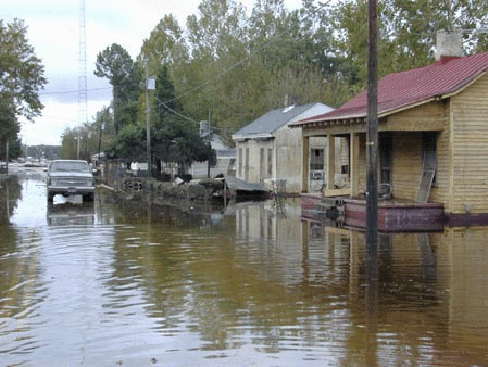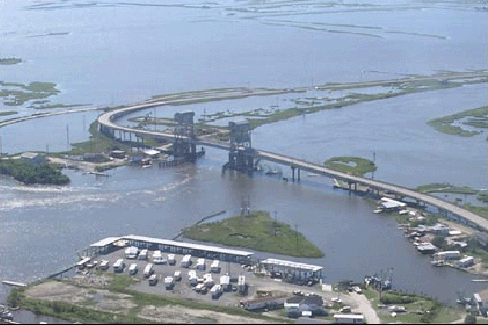Part 3: Systematic Bias
“…an ingenious strategy for recycling natural disaster as class struggle”
Mike Davis, Ecology of Fear
| Michael Hoover, “Rowboat Federalism: The Politics of U.S. Disaster Relief; Part 1: History: The Problems Are Inherent” (28 November 2005) and “Rowboat Federalism: The Politics of U.S. Disaster Relief; Part 2: Politics: The Electoral Connection and Beyond” (2 December 5) |
Complexities associated with U.S. federalism that emerged in the middle third of the twentieth century can make it difficult to sort out certain patterns of bias in the system. Nevertheless, there are two areas where biases are quite apparent: 1) biases against racial minorities; and 2) biases against lower-income people generally. For example, “dual federalism” — in which national and state authorities are separated — has been more detrimental to minorities than has the nationally-dominant intergovernmental federalism associated with the New Deal and the Great Society. Recall that, for much of the nation’s history, states’ rights have been asserted to protect slavery, segregation, and discrimination. Similarly, perennial battles over federalism have often masked whether government commitment to the social-service state will be more or less inadequate for low-wage workers and others living near or below the poverty line. Again, history indicates that an expanded federal role placed more — admittedly slight — economic resources into the hands of the poor, which contributed to reducing by half the percentage of persons living in poverty. Therefore, one should not be surprised that federal government cutbacks have generally been harmful to the same categories of people that were vulnerable under dual federalism.
Federal responsibility for emergency relief has increased dramatically since 1950, when Congress passed the first national disaster relief act. By the mid-1970s, Washington had assumed responsibility for about 75% of such costs, a percentage that the 1988 Federal Disaster Relief (“Stafford”) Act standardized. Since that time, however, presidents have used the discretion that disaster legislation offers them to raise the federal share to 100% in more than twenty instances. Surprisingly (well, maybe not), data on outlays incurred by the U.S. for weather-related disasters are not comprehensive because the government neither maintains a full listing of occurrences nor conducts a regular accounting of costs, although estimates range between $6-10 billion dollars in a “normal” year. While susceptibility to natural hazard disasters is correlated with both high and low-income residential patterns, federal disaster programs are primarily directed towards the former. Unfortunately for the poor, an enlarged federal role in this instance has failed to produce even modestly “progressive” results; the socio-economic state of affairs that puts them at risk to begin with works against them afterwards.
High-end coastal and mountain construction makes eco-systems more fragile and vulnerable, putting both nature and people at risk. Development removes trees, destroys barrier islands, and “replaces” wetlands that act like sponges to absorb rain into the earth with concrete and asphalt surfaces. About 50% of US wetland has been lost to this process (Louisiana loses the equivalent of a football field every 35 minutes), its disappearance aggravated by the “relative calm” of weather-related natural hazard activity in the 1970s and 1980s that encouraged building where it should not have happened. What’s more, increasing federal emergency assistance has lessened demand for private disaster insurance, in effect, providing public subsidies to flush Californians, whose hillside homes are destroyed by fires or mudslides, and wealthy Floridians, whose condos and beachfront homes are damaged by hurricanes, to rebuild. In the meantime, real estate interests and the home-building industry challenge local government’s authority to restrict private land use, including establishing erosion setbacks.
Builders and developers resist stricter safety codes as well, lobbying against flood-proofing requirements (such as raising the foundations of new structures), mandatory storm shutters, and obligatory “safe structures” in mobile home parks. Opposition to such regulations extends to rental-property owners wanting to avoid retrofitting existing properties. Of course, the existence of stronger building codes is meaningless in the absence of enforcement; Florida’s Office of Insurance Regulation has indicated that upwards of 40% of the damage incurred from 1992’s Hurricane Andrew could have been avoided with better enforcement. Meanwhile, many “manufactured housing communities” — to use industry vernacular — and poor neighborhoods can be found in disaster-prone floodplains (some 10 million residences, approximately 7% of U.S. housing stock). Additionally, regardless of where located, neither manufactured nor non-reinforced masonry housing — the latter prevalent among older and inadequately maintained rental dwellings — provides much protection from tornadoes and high hurricane winds. With the cost of purchasing a house soaring in recent decades, more people have turned to mobile homes; 33% of new U.S. housing purchases are now for manufactured units. According to a study done after Hurricane Andrew devastated the city of Homestead, mobile homes were 20 times more likely to be destroyed than conventionally constructed houses. Almost fifteen years later, only 14% of Florida mobile homes (the state “leads” the nation in the number of them) meet post-Andrew wind standards, while 29% were built before 1976 when no manufacturing or design standards existed at all.
The bias of federal disaster policy towards homeownership is apparent; one’s post-disaster “entitlement” subsidy is tied to financial and material status. Even in below-sea level New Orleans, for example, 60% of homeowners had no flood insurance. In contrast, renters living in mobile homes and sub-standard housing lose their possessions, but having no claims to residential property, they are less likely to receive much in the way of financial compensation following a catastrophe. Among these folks are the easiest of targets for scam artists and price gougers. Thus are the already existing troubles of those pushed to the end of the line by rowboat federalism — lower wages and higher unemployment, little (if any) insurance or savings, limited access to channels of communication and information — exacerbated. Moreover, the mass media can be complicit in this neglect as it was in its Loma Prieta earthquake coverage focusing upon the affluent San Francisco marina district and ignoring largely migrant farm worker Watsonville located near the epicenter or in its “naming” of the “Northridge” quake, the epicenter of which actually was in the economically less-affluent Reseda, California. Is it any wonder that legal services lawyers take FEMA and other government agencies to court for neglecting the poor after almost every tragedy?
Racial and social class biases can endanger the very existence of long-established communities as when posh residential development exacerbates the rate at which river water threatens those living down-stream. Consider the plight of historic Princeville, a small, black-majority town on the banks of North Carolina’s Tar River founded by former slaves after the Civil War. Most of the village was swept away in 1999 when Hurricanes Dennis and Floyd dumped rain into an already saturated area. Sprawling development upriver meant that large quantities of storm water were forced off hardened surfaces into feeder streams, transforming the Tar River into a ferocious behemoth. A year later, nearly one-third of the town’s 875 households were still living in temporary housing, although they were in trailers rather than makeshift shelters at a campsite that residents named “FEMAville.” In the interim, the Federal Emergency Management Agency proposed a buyout of the town; the agency’s disaster mitigation strategy under Clinton-appointed director James Lee Witt included efforts to move people from frequently flooded areas. FEMA, in fact, had overseen the largest voluntary relocation in U.S. history following the Great Mid-West Flood of 1993, a move of some 5100 homes and businesses in Illinois and Missouri (relocation cost: $66 million in a region that had previously received about $200 million in relief funds). However, in Princeville — which had been flooded five times in its history, the last in 1958 prior to levee construction — the agency offered an all-or-nothing deal requiring everyone to leave. Citizens fought the forced relocation, and, six years later, about 75% of the town’s physical infrastructure has been rebuilt at a cost of some $25 million in federal, state, and private assistance. No 100% Washington, D.C. responsibility in this instance!

Princeville, North Carolina, Flooded by Hurricane Floyd, 1999
The rowboat federalism of Princeville’s experience differs greatly from what might be called showboat federalism in beach towns where disaster funds “protect” the development boom that has transformed the nation’s seashores from sleepy hamlets to exclusive resorts. Congress, in 1986, prohibited FEMA from “means-testing” distribution of federal relief money (in contrast to social welfare programs requiring proof that someone is poor enough to qualify for support). A beach club is as eligible to receive repair funds as a school; in fact, under FEMA rules, beaches are considered part of the same public infrastructure that includes hospitals and utilities. This legislation, in effect, allows affluent communities to evade liability for the risks and costs of storm-prone construction. Today, approximately 40% of federal disaster dollars go to coastal areas. Wealthy beneficiaries have included a golf course in Key Biscayne, Florida and a marina in Miami that received $300,000 and $3 million dollars, respectively, to replace trees and restore yacht dockings after 1992’s Hurricane Andrew, New Jersey’s Lock Arbor Village which received $320,000 in the same year to rebuild a storm-damaged clubhouse, and Emerald Isle, North Carolina, “awarded” $1.5 million dollars following Hurricane Isabel in 1999 for street signs, athletic facilities, and beach sand. Not to be outdone, however, inland resort Palm Springs, California secured $750,000 to restore erosion and purchase new carts for a golf course built in a dry wash (a bed of an irregular stream) that is subject to flash floods.
Natural hazard disasters consistently harm some people more than others: “under-developed” countries, “have-nots” and the powerless, the aged, the ill and the infirmed, women and children (both relief programs and post-disaster reports typically ignore ways in which gender structures hazard impact as well as emergency response). So 2004’s Hurricane Jeanne, which left 2000 Haitians dead, killed only 70 in Florida, while low-income people comprise the largest number of U.S. weather-related disaster fatalities. Such circumstances make Cuba’s success in limiting hurricane deaths, for which the catalyst was the 1000-plus that died amidst the destruction caused by Hurricane Flora in 1963, all the more impressive. Only sixteen deaths were attributed to six major hurricanes that struck the island between 1996 and 2002. Together, Hurricanes Charley (2004) and Wilma (2005) killed at least 62 people in the U.S., but only four in Cuba, where effective emergency communications, reinforced lessons of past catastrophes, and mobilized neighborhood organizations combine to move, feed, and shelter upwards of two million people in mandatory evacuations. As for the deaths from Katrina, that goes without saying.
The National Hurricane Center (NHC) website “history” page begins with the 1900 storm that wiped out Galveston, Texas, leaving, according to various estimates, between 6,000 and 12,000 persons dead. Whatever the actual figure, it remains the nation’s highest-ever weather-related disaster death toll. Unfortunately, NHC’s failure to include pre-twentieth century hurricanes diminishes our collective memory (recordkeeping dates to 1851; forecasters began naming storms in 1950). The Galveston catastrophe occurred near the mid-point of fifty years of intense hurricane activity in the Atlantic Ocean and the Gulf of Mexico. Only seven years earlier, “killer” storms had come ashore in Louisiana and South Carolina and left upwards of 4000 dead. While the 1900 calamity is common knowledge, few have ever heard of the 1893 tragedies; those killed in the storms of that year were largely black, the dead in Galveston were almost all white. Similarly, awareness of the 1935 Florida Labor Day hurricane that killed some 400 persons contrasts sharply with ignorance of a 1928 storm in the same state that recently had its seven-decade-old official body count increased by the NHC from 1836 to 2500 (a number that might be as high as 3000 according to one researcher). Most of the dead in 1935 were white World War I veterans working in the Florida Keys as part of a New Deal public relief program. Those who perished in the 1928 “Okeechobee” hurricane were mostly black migrant workers, marginalized in life and ignored in death. Almost 80 years later, Katrina-related casualties were concentrated among the poorest New Orleanians living in the lowest areas of the city that were the most vulnerable to flooding. Those most likely to die were elderly and African-American; in fact, 60% were black and 61 years of age or older. Clearly, rowboat federalism is still leaking for those below the “water line.”
Further Reading
Fothergill, Alice, et al. 1999. “Race, Ethnicity, and Disasters in the United States: A Review of the Literature.” Disasters 23.2: 156-173.
Kleinberg, Eliot. 2003. Black Cloud: The Great Florida Hurricane of 1928: Carroll & Graf Publishers.
Morrow, Betty Hearn. 1999. “Identifying and Mapping Community Vulnerability.” Disasters 23.1: 1-18.
Place, Susan & Christine M. Rodrique. 1994. “Construction of the ‘Northridge’ Earthquake in English and Spanish Print Media in Los Angeles.” Proceedings of the International Geographical Union.
Platt, Rutherford. 2005. “Learning from Disasters: The Synergy of Law and Geography.”
—–. 2000. “Extreme Natural Events: Some Issues for Public Policy.”
Radix – Radical Interpretations of Disaster
Social Science Research Council. 2005. “Understanding Katrina: Perspectives from the Social Sciences.”
Sturgis, Sue. 2005. “Fear and Flooding in North Carolina: A Hurricane-Harried African-American Town Lives With the Specter of Future Disaster.” Southern Exposure 32.
Vatsa, Krishna & Frederick Gromgold. 2000. “Financing Disaster Mitigation for the Poor” (originally published as Chapter 12 in Kreimer, Alcira and Margaret Arnold (eds.). Managing Disaster Risk in Emerging Economies: World Bank).
 Michael Hoover is a professor of political science at Seminole Community College. Hoover co-authored City on Fire: Hong Kong Cinema. with Lisa Odham Stokes. Hoover serves on the editorial board of New Political Science, journal of the caucus for a new political science.
Michael Hoover is a professor of political science at Seminole Community College. Hoover co-authored City on Fire: Hong Kong Cinema. with Lisa Odham Stokes. Hoover serves on the editorial board of New Political Science, journal of the caucus for a new political science.


